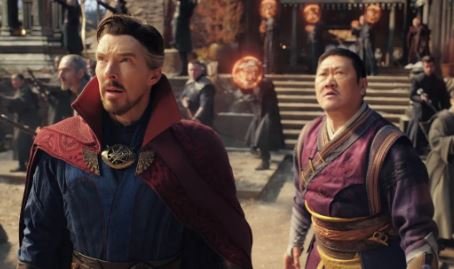A Boring Corporate Slog, "Doctor Strange in the Multiverse of Madness"
In the first "Doctor Strange" movie, a quirky character was introduced through an appropriate cinematic oddity, but in the second, "Doctor Strange in the Multiverse of Madness," the character is crammed into the Marvel universe by eliminating all the whimsy. The embrace of its protagonist's oddity in the first "Doctor Strange" solidifies him as one of the fictional characters in the franchise, which is its main strength.
The follow-up is conservative; the bizarreness is curbed, and the story's figurative loose ends are fixed with links to other Marvel characters and plots. (The ecstatic "Ant-Man" suffered the same fate in its sequel.) In the name of formula—of Marvel's self-sustaining enterprise—"Doctor Strange in the Multiverse of Madness" eliminates the lighthearted eccentricity. The new movie is branding as entertainment rather than just branded entertainment.
In "Multiverse of Madness," Stephen Strange (Benedict Cumberbatch), a former neurosurgeon who gained magical abilities after losing his hand-eye coordination in a car accident, has a dream about trying to save America Chavez (Xochitl Gomez), a teenager, from the clutches of a monster that threatens to rip her limb from limb. Because America has the capacity of traveling across universes (and dreams are portals—so much for Freud), the nightmare turns out to be an alternate reality. She introduces Strange to the concept of several universes, and he eventually experiences one of them firsthand while attending Christine Palmer's wedding (Rachel McAdams), He sees another monster on the loose in midtown Manhattan, a doctor and former colleague whom he loves and had intended to marry. He launches himself into war from a celebratory balcony. It turns out that Wanda Maximoff, a.k.a. the Scarlet Witch (Elizabeth Olsen), is so desperate to be reunited with her two young sons in an other world that she seeks to seize control of America (and, yes, the script is filled with such double-entendres). She is ready to murder the girl and decimate large populations. Wanda cannot be persuaded to change her evil plan by reason or moral argument, thus Strange, his lifelong comrade Wong (Benedict Wong), Christine, and America herself must engage the all-powerful sorceress in apocalyptic fight.
Along the journey, Strange runs with and fights a ton of other Marvel characters, including Karl Mordo (Chiwetel Ejiofor), a friend and foe, and other delegates from such a wide spectrum of Marvel titles that they might as well be wearing nametags and doing team-building exercises. Both useful and promotional, the movie. It's an omnium-gatherum of the company's films, television shows, and comic books—an effort to promote these works and position them as necessary viewing in order to follow the action. (Do not worry; even if you have missed "WandaVision" and "Inhumans," you can still grasp everything just fine.) It serves as a guide for developing future projects involving these as-yet-undeveloped materials. Similar many roles are played by the intricate alt-worlds concept. It takes away all conclusive outcomes from the Marvel franchise's dramas—a commercial trick that first surfaced when Thanos's murderous rampage at the conclusion of "Avengers: Infinity War" proved reversible. Additionally, it increases the amount of potential plots and qualities that well-known characters can anchor.
